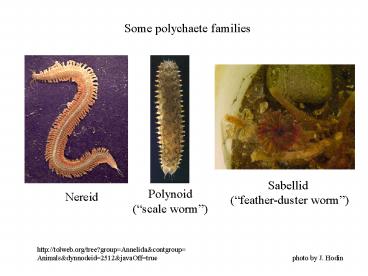http://tolweb.org/tree?group=Annelida PowerPoint PPT Presentation
1 / 16
Title: http://tolweb.org/tree?group=Annelida
1
Some polychaete families
Sabellid (feather-duster worm)
Polynoid (scale worm)
Nereid
http//tolweb.org/tree?groupAnnelidacontgroup A
nimalsdynnodeid2512javaOfftrue
photo by J. Hodin
2
Close-up of feather-duster worm (Polychaeta
Sabellidae) radioles
http//sorrel.humboldt.edu/els15/Zoo314.html
3
more polychaete families
serpulid (Serpula vermicularis)
terrebellid (spaghetti worm)
spionid
http//www.personal.psu.edu/users/ a/l/aln142/char
acteristics.htm
http//sorrel.humboldt.edu/ els15/Zoo314.html
4
Regeneration in the spionid polychaete, Pygospio
elegans
Gibson Harvey, Biol. Bull. 199 4149. (August
2000)
5
Poecilogony (egg eating) in annelid larvae
Boccardia proboscidea (Polychaeta
Spionidae) setiger larvae eating their siblings
a typical polychaete setiger-stage feeding
larva
http//ace.acadiau.ca/science/biol/ GGIBSON/resear
ch.htm
http//www.microscopy-uk.org.uk/ mag/artmar99/poly
ch.html
6
Epitoky by stolonization in syllid polychaetes
From Franke (1999) Hydrobiologia 40239-55
7
A Pacific Northwest Ribbon Worm (PHYLUM
NEMERTEA), Tubulanus sexlineatus
is this worm segmented or not?
collected April 16, 2002, Carkeek park
8
Nemertine proboscis, rhynchocoel and style
From Kozloffs Invertebrates (1990)
9
PHYLUM GASTROTRICHA
considered one of the "minor" phyla, but can be
incredibly abundant in marine and fresh water
sediments (up to 100,000 individuals in 1 m2!!)
http//www.micrographia.com/specbiol/gastrot/gastr
o/gast0100.htm
http//www.earthlife.net/inverts/gastrotricha.html
10
PHYLUM CHAETOGNATHA ("arrow worms")
all are vicious carnivores, use neurotoxins to
capture prey (see p. 443 in Pechenik) most are
holoplanktonic, and can be quite abundant in the
plankton (up to several hundred individuals per
m3 of sea water!)
photos by Jean-Marie Cavanihac http//www.microsc
opy-uk.org.uk/mag/artjan00/chaet.html
11
a Hawai'ian arrow worm baby!
Kaneohe Bay, Oahu
12
THE "ECDYSOZOA" - molting animals
a sub-group of the Protostomes, including
arthropods and nematodes (round worms), as well
as less -well-known groups like the nematomorphs
(gordian worms), onycophorans (velvet worms),
tardigrades (water bears) and rotifers (wheel
animalcules) all of them have rigid
exoskeletons, usually made of chitin (a
polysaccharide, similar to cellulose) in order
to grow, ecdysozoans molt their old cuticles, and
produce a larger cuticle in the layer
below between the arthropods (the most speciose
animal phylum BY FAR) and the nematodes
(possibly the most numerous animal on the
planet), it seems that this molting life style is
very successful. Why?
chitin
cellulose
13
Nematodes - the round worms
http//www.ucmp.berkeley.edu/phyla/ecdysozoa/nemat
oda.html
14
Nannophya pygmaea from Malaysia. Worlds
smallest dragonfly (15 mm)!!
The stomatopod Odontodactylus scyllarus picture
by Don Trowbridge
http//www.ups.edu/biology/museum/UPSdragonflies.h
tml
CRUSTACEA
INSECTA
TRILOBITA
The five classes of arthropods
the Goose Barnacle, Pollicipes polymerus http//ww
w3.ocn.ne.jp/kmitoh/ zaturoku/ebosigai/e_ebosigai
.html
MYRIAPODA
CHELICERATA
Neoasaphus http//www.aloha.net/ smgon/eyes.htm
Hadrurus arizonensis pallidus
http//www.creature-creations.com/g6c40.html
http//www.desertusa.com/oct96/du_scorpion.html
15
the insects
I. the ancestrally wingless insects II.
the "hemimetabolous" (non-metamorphosing)
insects I. the "holometabolous"
(metamorphosing) insects
including the orders Collembola (springtails)
and Thysanura (silverfish) including
the orders Orthoptera (grasshoppers crickets)
and Blattodea (cockroaches), Hemiptera (aphids,
the "true" bugs), Isoptera (termites), Phasmida
(leaf insects, walking sticks), Ephemeroptera
(mayflies) possibly including the order Odonata
(dragonflies and damselflies) including
the orders Diptera (flies and mosquitoes),
Lepidoptera (moths and butterflies) Hymenoptera
(bees wasps and ants), Neuroptera (lacewings, ant
lions, dobson flies) and the Coloeptera (beetles
and weevils)
16
PHOTOS ON THE PREVIOUS SLIDE
SPRINGTAIL http//www.ext.vt.edu/departments/ento
mology/factsheets/springta.html SILVERFISH
http//ohioline.osu.edu/hyg-fact/2000/2108.html
(all of the color photos were from the Tree of
Life insect pages) MAYFLY by T. W. Davies BUG
by Jean-François Cornuet GRASSHOPPER by Joseph
L. Spencer DAMSELFLIES by Jo-Ann Ordano BEE
by Joseph L. Spencer BEETLE by Robert Potts

